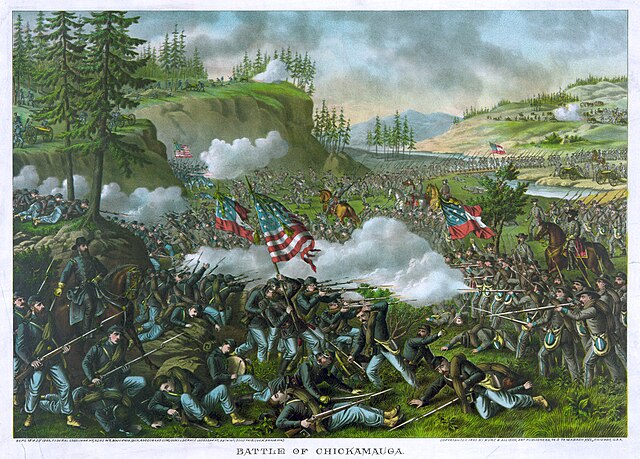Video: 'Chickamauga: Animated Battle Map'
(Sunday, September 20, 1863, 7:30 p.m. local time; in the Western Theater of the American Civil War) — The Battle of Chickamauga, fought between Union and Confederate forces in the American Civil War since Friday, September 18, 1863, in northwestern Georgia, ended tonight in a Confederate victory when three Union regiments that had been attached from other units—the 22nd Michigan, the 89th Ohio, and the 21st Ohio—were surrounded by Brig. Gen. William Preston’s division and forced to surrender.
It was the first major battle of the war fought in Georgia, the most significant Union defeat in the Western Theater, and involved the second-highest number of casualties after the Battle of Gettysburg.
The battle was fought between the Union Army of the Cumberland under Maj. Gen. William Rosecrans and the Confederate Army of Tennessee under Gen. Braxton Bragg, and was named for Chickamauga Creek.
After his successful Tullahoma Campaign, Rosecrans renewed the offensive, aiming to force the Confederates out of Chattanooga, Tennessee.
In early September, Rosecrans consolidated his forces scattered in Tennessee and Georgia and forced Bragg’s army out of Chattanooga, heading south. The Union troops followed it and brushed with it at Davis’s Cross Roads.
Video: 'Civil War Combat: The Bloody Battle Of Chickamauga (S1, E2) | Full Episode'
Bragg was determined to reoccupy Chattanooga and decided to meet a part of Rosecrans’s army, defeat it, and then move back into the city. On September 17, he headed north, intending to attack the isolated XXI Corps.
As Bragg marched north on September 18, his cavalry and infantry fought with Union cavalry and mounted infantry, which were armed with Spencer repeating rifles. The two armies fought at Alexander’s Bridge and Reed’s Bridge, as the Confederates tried to cross the West Chickamauga Creek.
Fighting began in earnest on the morning of September 19. Bragg’s men strongly assaulted but could not break the Union line.
The next day, today, Bragg resumed his assault. In late morning, Rosecrans was misinformed that he had a gap in his line.
In moving units to shore up the supposed gap, Rosecrans accidentally created an actual gap directly in the path of an eight-brigade assault on a narrow front by Confederate Lt. Gen. James Longstreet, whose corps had been detached from the Army of Northern Virginia.
Video: 'Ken.Burns.The.Civil.War.5of9.The Universe of Battle.' (Battle of Chickamauga at 1:13:45)
In the resulting rout, Longstreet’s attack drove one-third of the Union army, including Rosecrans himself, from the field.
Union units spontaneously rallied to create a defensive line on Horseshoe Ridge (“Snodgrass Hill”), forming a new right wing for the line of Maj. Gen. George H. Thomas, who assumed overall command of remaining forces.
Although the Confederates launched costly and determined assaults, Thomas and his men held until twilight. Union forces then retired to Chattanooga while the Confederates occupied the surrounding heights, besieging the city.
The battle was damaging to both sides in proportions roughly equal to the size of the armies: Union losses were 16,170 (1,657 killed, 9,756 wounded, and 4,757 captured or missing), Confederate 18,454 (2,312 killed, 14,674 wounded, and 1,468 captured or missing).
They were the highest losses of any battle in the Western Theater during the war and, after Gettysburg, the second-highest of the war overall.

